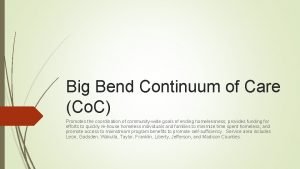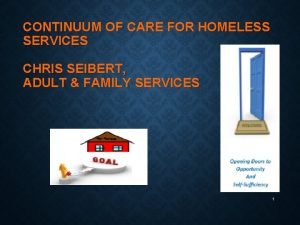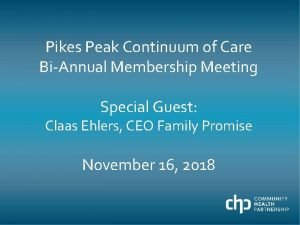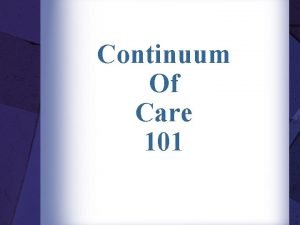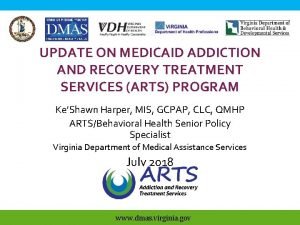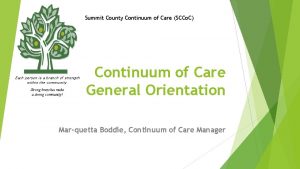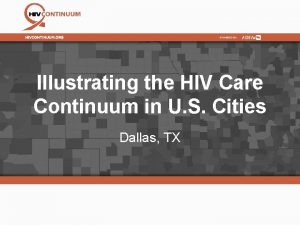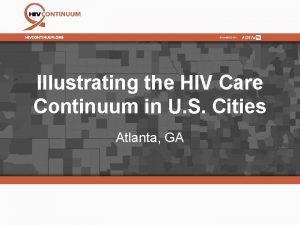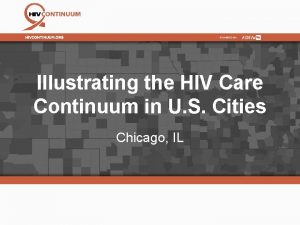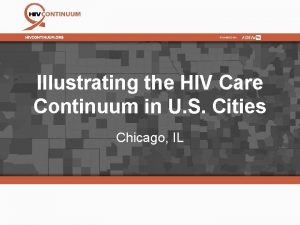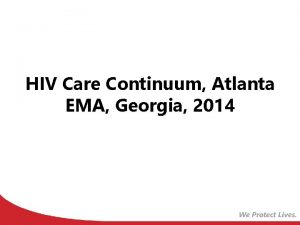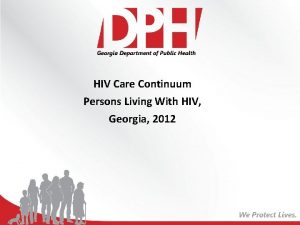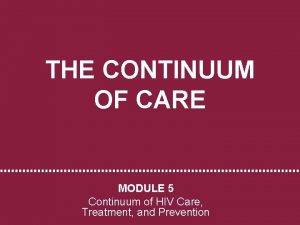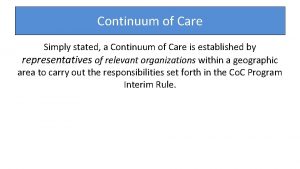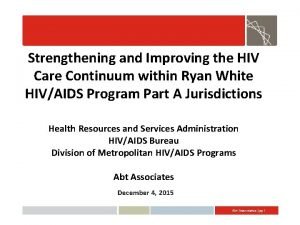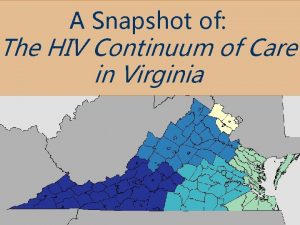Illustrating the HIV Care Continuum in U S













- Slides: 13

Illustrating the HIV Care Continuum in U. S. Cities Illinois

About Effective treatment requires successful HIV diagnosis as well as linkage and retention in HIV care - this is the HIV care continuum. To be the most impactful, public health strategies that address gaps in the HIV care continuum will require detailed information on disproportionately impacted populations. HIVContinuum. org is a compilation of interactive, online maps that allows users to connect with complex information about the HIV care continuum in several highly impacted cities in the U. S. HIVContinuum. org is powered by AIDSVu and uses public health surveillance data to increase understanding of the HIV treatment cascade by visualizing the impact of HIV on specific demographic groups, neighborhoods and Countys.

Interactive Maps at the County Level New HIV Diagnoses Late HIV Diagnoses Linkage to HIV Care Engagement in HIV Care HIV Viral Suppression

Supporting the National HIV/AIDS Strategy Prevent new HIV infections Improve care and treatment Reduce HIV-related health disparities HIVContinuum provides a new way to identify places where we can improve HIV testing, care and treatment.

Five-Year Risk of New HIV Diagnosis, by County, Illinois, 2010 -2014 Five-year risk of new HIV diagnosis, 2010 -2014 (per 100, 000 population of adults/adolescents in 2010) 0 -3 4 -5 6 -6 7 -9 10+ Not Shown* * Gray areas denote where data are not shown to protect privacy because of a small number of cases and/or a small population size. Notes: Data represent the 5 -year (2010 -2014) risk of new HIV diagnosis among the adult/adolescent population within each county/County. New HIV diagnoses and late diagnoses indicators come from a mature HIV case surveillance system. Linkage to care, engagement in care, and viral suppression are new indicators and rapidly developing, and thus accuracy and completeness will improve over time. For more information on data limitations and caveats, please see Data Methods. Data Source: Illinois Department of Public Health Office of Health Protection, HIV Surveillance Unit

Proportion of those Newly Diagnosed with HIV Late in the Course of HIV Infection, by County, Illinois, 2010 -2014 Proportion of adults/adolescents newly diagnosed with HIV from 2010 -2014 with an AIDS diagnosis within 3 months of HIV diagnosis 0 -10 % 11 -20 % 21 -30 % 31 -50 % >50 % Not Shown* * Gray areas denote where data are not shown to protect privacy because of a small number of cases and/or a small population size. Notes: The data represents the proportion of adults/adolescents diagnosed with HIV between 2010 -2014 within each county/County who were diagnosed late in the HIV disease process. Late HIV diagnosis was defined as immunologic or clinical AIDS (new CDC classification as A 3, B 3, or C 1 -C 3) within 3 months of initial HIV diagnosis. New HIV diagnoses and late diagnoses indicators come from a mature HIV case surveillance system. Linkage to care, engagement in care, and viral suppression are new indicators and rapidly developing, and thus accuracy and completeness will improve over time. For more information on data limitations and caveats, please see Data Methods. Data Source: Illinois Department of Public Health Office of Health Protection, HIV Surveillance Unit

Proportion of those Newly Diagnosed with HIV 2010 -2014 who were Linked to HIV Care, by County, Illinois Proportion of adults/adolescents newly diagnosed with HIV from 2010 -2014 with a reported CD 4/viral load within 3 months of HIV diagnosis 85 -100 % 75 -84 % 60 -74 % 50 -59 % >50 % Not Shown* * Gray areas denote where data are not shown to protect privacy because of a small number of cases and/or a small population size. Notes: Data represents the proportion of adults/adolescents diagnosed with HIV between 2010 -2014 within each county/County who were linked to HIV care within 1 month of their diagnosis. New HIV diagnoses and late diagnoses indicators come from a mature HIV case surveillance system. Linkage to care, engagement in care, and viral suppression are new indicators and rapidly developing, and thus accuracy and completeness will improve over time. For more information on data limitations and caveats, please see Data Methods. Data Source: Illinois Department of Public Health Office of Health Protection, HIV Surveillance Unit

Engagement in Care among those Living with Diagnosed HIV Infection in 2015, Excluding Those Newly Diagnosed in 2015, by County, Illinois Proportion of adults/adolescents living with diagnosed HIV infection in 2015, excluding those diagnosed in 2015, who had a suppressed HIV VL in 2015 90 -100 % 80 -89 % 70 -79 % 50 -69 % <50 % Not Shown* * Gray areas denote where data are not shown to protect privacy because of a small number of cases and/or a small population size. Notes: Data represent the proportion of adults/adolescents living with diagnosed HIV infection in 2015, excluding those newly diagnosed in 2015, who were engaged in care in 2015. Engaged in care for this indicator is defined as having a most recent CD 4 count or HIV viral load test in 2015. New HIV diagnoses and late diagnoses indicators come from a mature HIV case surveillance system. Linkage to care, engagement in care, and viral suppression are new indicators and rapidly developing, and thus accuracy and completeness will improve over time. For more information on data limitations and caveats, please see Data Methods. Data Source: Illinois Department of Public Health Office of Health Protection, HIV Surveillance Unit

HIV Viral Load Suppression among those Engaged in Care, who were Living with Diagnosed HIV Infection in 2015, Excluding those Newly Diagnosed in 2015, by County, Illinois Proportion of adults/adolescents living with diagnosed HIV infection in 2015, excluding those newly diagnosed in 2015, who had a suppressed HIV VL in 2015 and engaged in care. 80 -100 % 70 -79 % 60 -69 % 50 -59 % <50 % Not Shown* * Gray areas denote where data are not shown to protect privacy because of a small number of cases and/or a small population size. Notes: Data represents the proportion of adults/adolescents living with diagnosed HIV infection in 2015, excluding those newly diagnosed in 2015, who had a suppressed HIV VL in 2015 and engaged in care. Engaged in care for this indicator is defined as having a most recent CD 4 count or HIV viral load test in 2015. HIV viral load suppression is defined as the most recent viral load < 200 copies/ml. New HIV diagnoses and late diagnoses indicators come from a mature HIV case surveillance system. Linkage to care, engagement in care, and viral suppression are new indicators and rapidly developing, and thus accuracy and completeness will improve over time. For more information on data limitations and caveats, please see Data Methods. Data Source: Illinois Department of Public Health Office of Health Protection, HIV Surveillance Unit

HIV Viral Load Suppression Among Those Living with Diagnosed HIV Infection in 2015, Excluding Those Diagnosed in 2015, by County, Illinois Proportion of adults/adolescents living with diagnosed HIV infection in 2015, excluding those diagnosed in 2015, who had a suppressed HIV VL in 2015 80 -100 % 50 -79 % 40 -49 % 30 -39 % <30 % Not Shown* * Gray areas denote where data are not shown to protect privacy because of a small number of cases and/or a small population size. Notes: Data represent the proportion of adults/adolescents living with diagnosed HIV infection in 2015, excluding those newly diagnosed in 2015, who had a suppressed HIV VL in 2015. HIV viral load suppression is defined as the most recent viral load < 200 copies/ml. New HIV diagnoses and late diagnoses indicators come from a mature HIV case surveillance system. Linkage to care, engagement in care, and viral suppression are new indicators and rapidly developing, and thus accuracy and completeness will improve over time. For more information on data limitations and caveats, please see Data Methods. Data Source: Illinois Department of Public Health Office of Health Protection, HIV Surveillance Unit

The HIV Care Continuum Among Those Newly Diagnosed with HIV, by Demographic Groups, Illinois, 2010 -2014 Note: The color within each box corresponds to the most frequent category of the outcome at the Ward level for each subgroup. The categories for new HIV diagnoses were created from the overall data, therefore no mode exists (gray box). 1 New HIV diagnoses 2010 -2014 per 100, 000 persons 2 Proportion with AIDS within 3 months of diagnosis 3 Proportion with a CD 4 or viral load within 1 months of diagnosis 4 Proportion with a CD 4 or viral load in 2015 5 Proportion with suppressed HIV viral load in 2015 Data Source: Illinois Department of Public Health Office of Health Protection, HIV Surveillance Unit

Map Details • Data on HIVContinuum may differ from data released in local HIV surveillance reports. • The HIVContinuum maps do not reflect undiagnosed cases. • The case definitions and data systems for new HIV diagnoses and late HIV diagnoses are standard in HIV case surveillance, but standardization for the other indicators used here is still a work-inprogress. • More information about data methods and sources can be found at HIVContinuum. org.

Contact Information More map views are available at HIVContinuum. org For more information about HIVContinuum, including information about custom map views and images, please email info@hivcontinuum. org Connect With Us HIV Care. Continuum @HIVContinuum HIV Care Continuum
 Planning process
Planning process Emphasising connectives examples
Emphasising connectives examples Bad hair day art project
Bad hair day art project Illustrating connectives
Illustrating connectives Primary secondary tertiary health care
Primary secondary tertiary health care Continuum
Continuum Care continuum prior authorization
Care continuum prior authorization Continuum of care
Continuum of care Pikes peak continuum of care
Pikes peak continuum of care Continuum of care
Continuum of care Asam continuum of care
Asam continuum of care Continuum care greensboro nc
Continuum care greensboro nc Continuum of care reform
Continuum of care reform Summit county continuum of care
Summit county continuum of care





